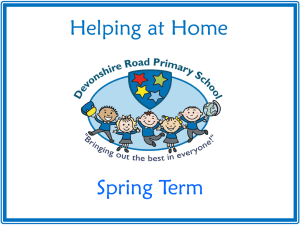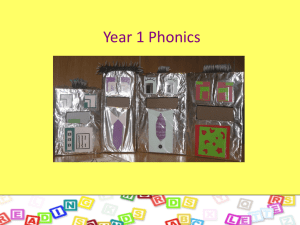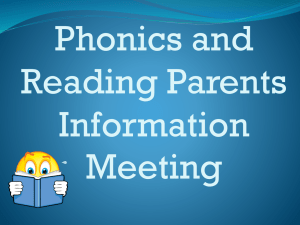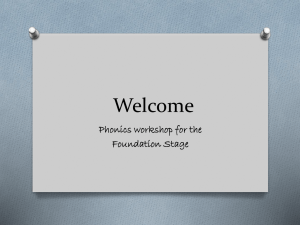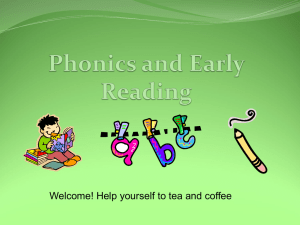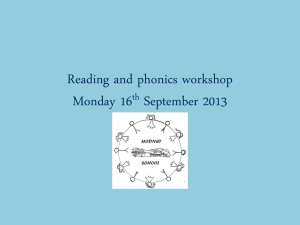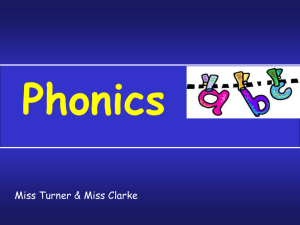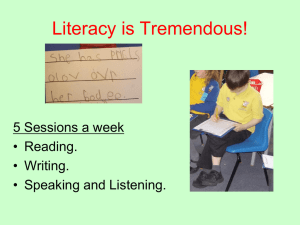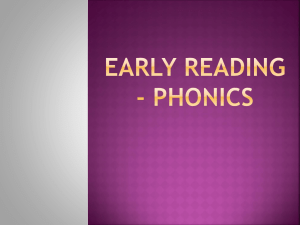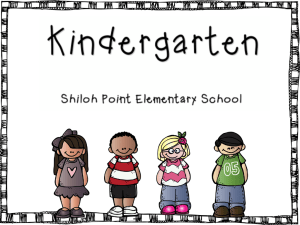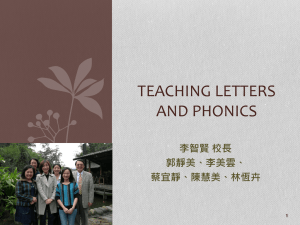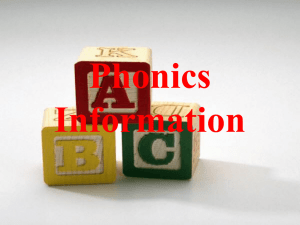Y1_Cracking_the_Code_1_March_11
advertisement
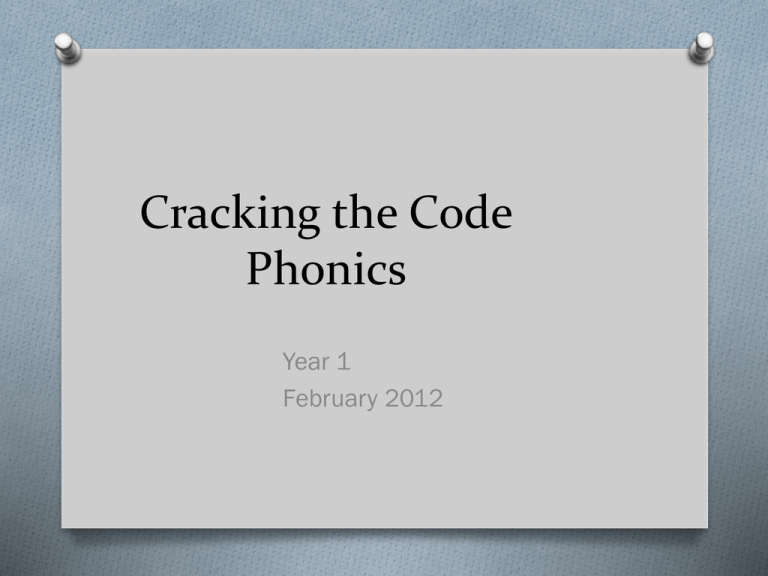
Cracking the Code Phonics Year 1 February 2012 Objectives O to consider children’s early experience of learning how to read O to be introduced to phonics and phonological awareness O to be introduced to the Rose Report O to understand how children use phonics to read unknown words O to know a range of teaching strategies to help children develop understanding of phonics Request students find any of the missing books from Hampshire Library Service: Baker J Browne A Hoffman M Kelly J Norriss A Sheldon D Tomlinson J Dark O Wormell C O Mathhews A O O O O O O O Window Voices in the Park Amazing Grace Scoop (2 copies) Control Z Whale Song The Owl Who was Afraid of the Two Frogs Bob Robber and Dancing Jane Reflection on SE1 Discuss in groups: O What English teaching did you observe? O What English teaching did you take part in? O How did your Lost and Found guided reading go? O How did your experiences correspond to what was learned at uni in S1 ? Phonics O What phonics teaching did you observe on school experience? The Simple View of Reading (The Rose Cross) How do children develop as readers? cueing strategies comprehension: literal and inferential phonemic awareness grapheme phoneme correspondence motivation enjoyment choices phonic knowledge experience of different genres talking about books and reading What is auditory discrimination? It can be defined as: O An awareness of sound all around us. Starting before birth we hear different sounds and can distinguish between them What is phonological awareness? O The awareness of sounds within words O Syllables O Onset and rime O Phonemes O Refers only to speech i.e. you don’t need to be able to read Phonemic awareness: Phonics O Phonics is the ability to apply that phonemic knowledge to the alphabet. O To be able to apply sounds to graphemes. O Phonics is when a child can attach a drawing from the symbols in the alphabet to a sound – it is a code The alphabetic principle O There are 44 phonemes O A phoneme can be represented by one or more letters (cat, that, hair, caught) O The same phoneme can be represented/spelled in more than one way (Rain, may, lake) O The same spelling may represent more than one phoneme (mean deaf) Vowels and consonants O Vowels are phonemes where air flows through the mouth unobstructed, e.g. the letters a, e, i, o, and u O Consonants are phonemes marked by constriction or closure in the breath channel - letters other than a, e, i, o and u. What are phonemes and graphemes O A phoneme is the smallest unit of sound in a word e.g. p-i-n m-a-n c-o-t O A grapheme is the written representation of a sound O A really useful guide is available on the strategy website at Phoneme hearing exercises a) How many phonemes in: O cat O dog O ship O leg O chin O Pen O Crop O lap spin trip map shop net photo stick thin Digraphs-consonant O A digraph is two letters together which make one sound. O There are consonant digraphs e.g: sh, th, ch, ng, ph As a group can you make a list of ten words using consonant digraphs on your paper? O What do you notice about the phonemes and graphemes? Digraphs-vowel O There are 5 vowels in the alphabet but more vowel sounds Trigraphs O A trigraph is a three letter grapheme where three letters represent one phoneme O Can you think of any words which have phonemes which need three letters? O Write them on your wipe board with a partner O Can you think of any words which have phonemes with 4 letters? What is a split digraph? O A vowel digraph is split by a consonant. O gate O lake O made O site O time What is synthetic phonics? O Children are taught individual letters, or groups of letters and their sounds. They learn to blend (synthesise) letters together to form words O They read unknown words by breaking them down in to phonemes (decoding). E.g. c-a-t Analytic phonics Analytic phonics O Children are taught to decode words they do not know by using words or word parts they do know. O Using onset and rime is part of this system. If you can hear and spell c-at, then you can work out how to spell b-at. (analogy) O It works only for words where the rime is spelt identically. What does teaching look like? Letters and Sounds Phase 1 O Prepares children for phonic work. Based on listening and discriminating between sounds. Phase 2 O Single phonemes/graphemes are introduced. They understand that segmenting and blending are reversible processes. Read and spell simple CVC words. Phase 3 O In this phase the digraphs are introduced but not the split digraphs. Phase 4 O Here children are introduced to the adjacent consonants – e.g. ‘slip’ and ‘camp’. Phase 5 O Here they will learn that some spellings have alternative pronunciations e.g. cow and blow. And some sounds have alternative spellings e.g. ‘ jump’ and ‘hedge’. Phase 6 O A lot of teaching in this phase revolves around spelling e.g. prefixes ‘return’ and suffixes ‘sitting’. Also reading for meaning is empahasised. Phonics games on Web O http://www.bbc.co.u k/schools/wordsand pictures/phonics/sa ndcastle/index.shtml O BBC Words and Pictures O do the crab/ sandcastle one http://phonicsplay.co.u k/ phonicsplay.co.uk O go to phase 2 and do 'buried Treaure' game Directed Task O Directed task O Read through the handout provided O Choose at least one activity O Make this and bring to share at next week’s seminar Web links for the most commonly used phonics programmes O ReadWriteInc O O O O O http://www.ruthmiskinliteracy.com/default.aspx Jolly Phonics http://www.jollylearning.co.uk/ Collins Big Cat Phonics http://www.collinseducation.com/series/pages/seriesshow. aspx?Seriestitle=Collins%20Big%20Cat&Level1=Primary&Le vel2=Literacy THRASS http://www.thrass.co.uk/teaching.htm Letters and Sounds http://nationalstrategies.standards.dcsf.gov.uk/node/8496 9 The library Early Reading Collection has copies of many of the most used programmes in school Free resources O http://www.letters-and-sounds.com/ O http://www.thrass.co.uk/downloads.htm
